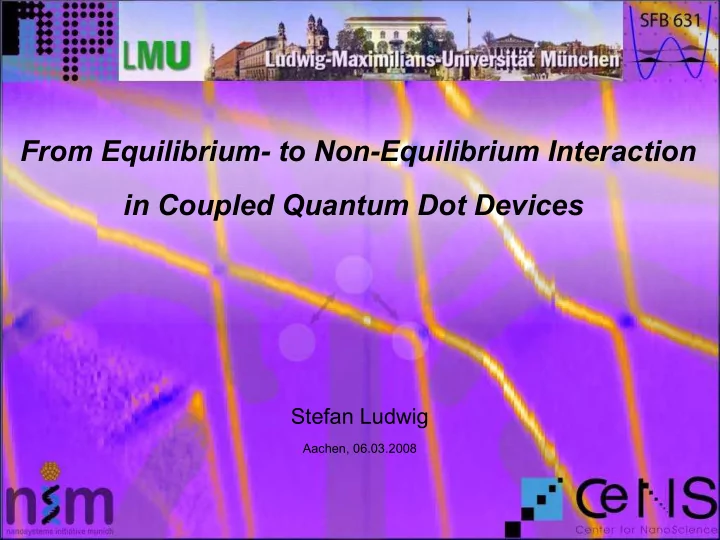

From Equilibrium- to Non-Equilibrium Interaction in Coupled Quantum Dot Devices Stefan Ludwig Aachen, 06.03.2008
O U T L I N E V C • few electron serial triple quantum dot V L V R α Q P C 500 nm • backaction of a quantum point contact charge detector • counterflow in 2 quantum point contacts
electrostatically defined quantum dots (QDs) plunger gate energy s A E F a G l A G E D s 2 A a G x tunnel barriers 250 nm
transport through a serial double QD current I (nA) V L (V) L R 1 m V I V R (V) current flows on triple points of the stability diagram
charge spectroscopy using a quantum point contact (QPC) in its tunneling regime V I transconductance of QPC G T = d I QPC d U gL L R has extrema on charging 1 m lines of the double QD G T V L (V) r N l N S D V R (V)
a serial few-electron triple quantum dot V C V L V R α 3 QDs ↔ 3 main slopes of charging lines Q P C 500 nm PRB 76 , 075306 (2007)
triple quantum dot stability diagram bistable region
bistable region – telegraph noise (011) is the ground state ! V C V L V R α Q P C 500 nm
boundaries of telegraph noise 1,0,0 0,0,2 what is the non-equilibrium energy source ?
bistable region in a DQD TQD DQD 300 nm arXiv:0801.4002, in cooperation with V C M. Pioro-Ladriere & A. Sachrajda (CIAR) QPC V L V R α α α V L V R QPC V p 500 nm
multiple bistable regions in a DQD V C V L α QPC 500 nm molecular states at triple points in
the driven QPC is the energy source in ≫ out ⇒ QD is permanently charged • position of charging line is always determined by in = out ; • equilibrium: at resonance condition in = out • non-equilibrium energy source: at resonance condition possible in ≠ out the nearby QPC used as charge detector provides non-equilibrium energy !
transition between atomic and molecular behavior gap for smaller than Lock-In frequency in = out atomic states at resonance molecular states out in
noise spectroscopy of excited states Г in and Г out change at interdot resonances TQD DQD arXiv:0801.4002, in cooperation with M. Pioro-Ladriere & A. Sachrajda (CIAR)
backaction of QPC 300 nm V C QPC V L V R α α α V L V R QPC V p 500 nm • a driven QPC always provides energy and causes telegraph noise (fluctuations between charge configurations) in coupled QDs • the noise will limit the coherence time of a qubit • the fluctuations can be directly observed only if slow enough ! is the energy mediated by phonons or by photons ?
interaction between two electrically separated QPCs drive QPC: S D I drive strong electron-hole asymmetry detector QPC: I det ? the two QPCs are electrically separated: no leakage current !
counterflow current in the unbiased QPC counterflow current I CF flows through the detector QPC in the opposite direction than I DRIVE PRL 99 , 096803 (2007)
counterflow current as a function of G det detector QPC: maximal effect for G det between plateaus d I cf g cf ≡ d V drive
counterflow current in the pinch-off regime ( G det = 0) ~0.5 meV g CF is enhanced compared to 4 T 0 (1- T 0 ) even in the pinch-off regime of the detector QPC → hot electrons ( E - E F ~ 0.5 meV) ! G 0 1 − G det G 0 transmission function: 4 T 0 1 − T 0 ≡ 4 G det
model in terms of asymmetric phonon based heating S D phonons electron-hole pairs 1.) hot electrons ( E - E F ~ 4 meV) scatter with Fermi-see ( E F ~ 8 meV) only in the right lead of the drive-QPC 2.) hot electrons emit phonons with maximal momentum of 2 k e → maximal E ph ~ 0.5 meV 3.) acoustic phonons are absorbed in the detector circuit by exciting electron-hole pairs with max. E e ~ 0.5 meV 4.) the resulting hot electrons pass the detector-QPC, but the “cold” holes are reflected → counterflow current
S U M M E R Y • full control of charge states in few electrons triple QDs achieved → triple QDs provide rich spectrum of physics going beyond that of double QDs (e.g. QCA- processes,...) • bounded (bistable) regions of telegraph noise observed in triple and double QDs → quantum point contact acts as non-equilibrium energy source → noise is always present, but usually too fast for charge detection → consequence: switch off charge detector during qubit operation for longer coherence times • counterflow through quantum point contacts → strongly driven quantum point contact provides phonons thank you !!
the team Jörg Kotthaus Daniel Harbusch Daniela Taubert wafers are grown by Vadim Khrapai W. Wegscheider K. Eberl Daniel Schröer (Uni Regensburg) (MPI for Solid State Physics)
Recommend
More recommend